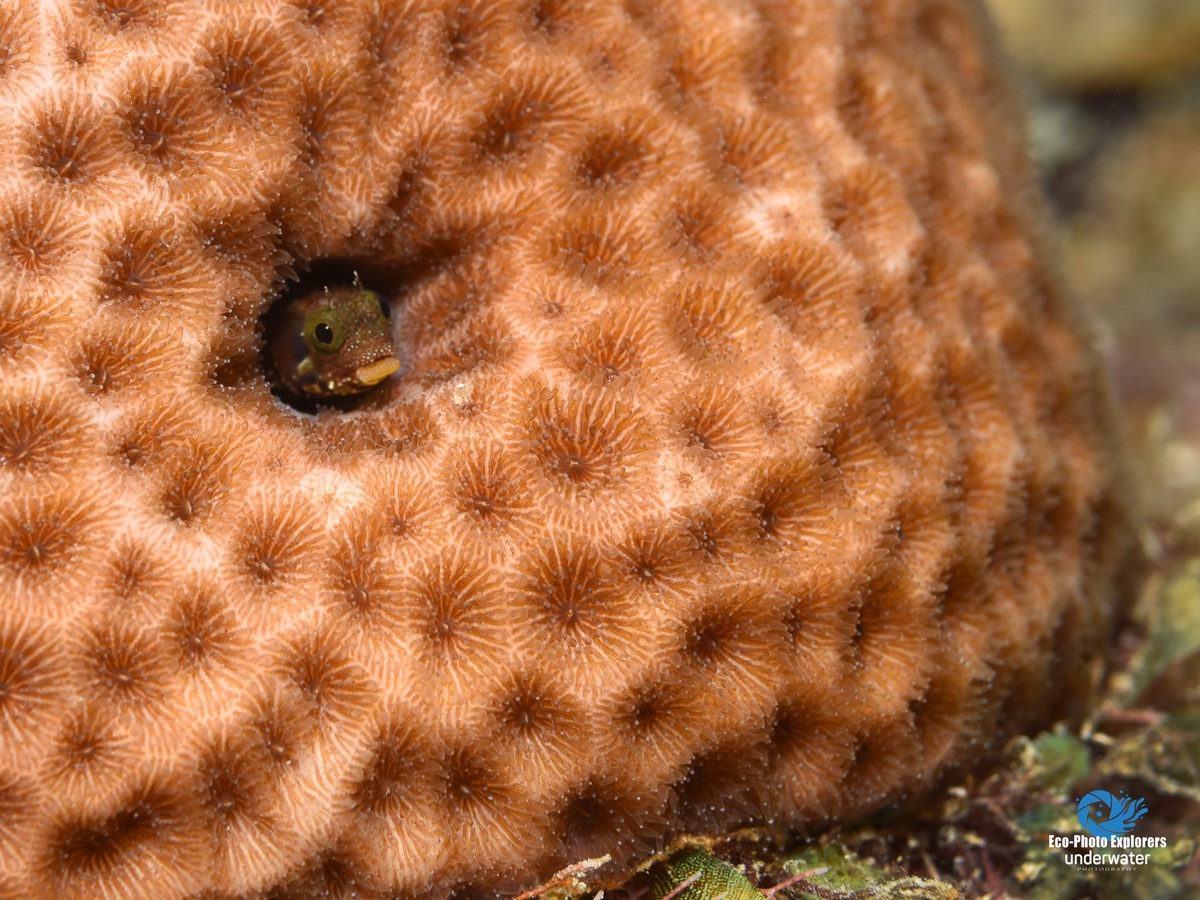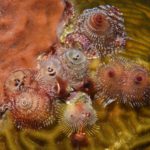
Squat Anemone Shrimp live alongside Anemones
With a blazing sun overhead, barely a whisper of a breeze over the water and only the slightest ripples on the surface, the crystal clear waters of the Caribbean beckoned from the stern as we prepared to giant stride off the dive boat into the underwater world of Barbados. The dive site was called Shark’s Back and with a step forward our underwater adventure began.
Words & Photos by Michael Salvarezza and Christopher P. Weaver
The familiar warmth of tropical water enveloped us and immediately we turned our gaze down to survey the reef below. Already, we could see graceful sea fans swaying in the water while flashes of color darted in and out of the coral’s nooks and crannies as the marine denizens of this spot off the western shores of the island went about their daily business. We descended to about 75 feet and began a leisurely swim along the reef edge. Along the way, we encountered some of the usual suspects that reside on Caribbean reefs: Squirrelfish, Four-eye Butterfly Fish and the occasional grouper hiding in the recesses of the reef. Our first dive was a great introduction to Barbados diving.
Roundbar reef was the second dive of the adventure, a healthy reef system that starts in about 45 feet of water and drops off the deeper levels the further west you go. Armed with our macro lenses, we busied ourselves taking images of the colorful Christmas tree worms that seemed to abound on the coral heads, along with Banded Coral Shrimp hanging out inside a barrel sponge. In the coral sand between coral mounds we spotted a Pearly Razorfish and spent time watching from a comfortable distance as this skittish fish darted around the coral rubble warily eyeing our presence. Our dive ended with a stare down of a lizardfish that eventually turned tail and swam away when we advanced one inch beyond its personal space comfort zone!

A female Rosy Razorfish darts about the sandy patches
Using day boats to explore the waters if Barbados afforded us the time to explore the island above the water. A visit to the Barbados Wildlife Refuge brought us face-to-face with its resident population of Green Monkeys, each with their own distinctive personalities. Some were shy, some were bold, all were cute!
Charles Fort is located at Needham’s Point. Erected in 1650 by the British military to protect Carlisle Bay from enemy attacks, visitors can find perfectly restored cannons that today seem to only be guarding the tourist beaches! Interestingly, in the waters at the foot of the fort, many more canons lie awash in the waves, unrecovered and unrestored. These remnants of history seemed to be abandoned and, for us, were a tantalizing tease! If only we could have scrambled into the water and figured a way to bring them ashore!

Amazingly these canons have never been recovered
For Lighthouse aficionados, there are several: The Needham’s Point Lighthouse sits just feet away from the Barbados Hilton…a juxtaposition of modern development and historical aids to navigation. There is also the Harrison Point, Ragged Point and South Point Lighthouses to explore.
Our diving adventure continued at Asta Reef. Located south of Bridgetown, this site is known for snappers, stingrays and barracudas. For us, again set up for Macro photography, it was Bristle Worms and Pederson’s Shrimp!
Carlisle Bay is a crescent shaped bay and harbor on the west side of the island. In earlier days, this was a harbor filled with merchant ships from Britain and other countries delivering goods to the island. Today it is home to catamarans and lucxury yachts. The bay is named after the Earl of Carlisle, James Hay, who was the Lord Proprietor of Barbados in the 1600s.

This old mill in a remnant from Barbados’ past
For SCUBA divers, there are six shipwrecks in the bay. Ranging in depth from as shallow as 12 feet to as deep as 55 feet, these wrecks attract a plethora of marine life. The wrecks are a barge, Cornwallis, Berwyn, Bajan Queen, C-Trek, and Eilon.
The barge was a naval landing barge sunk in 2003 and is sitting in 15 feet depth of water. The 120-foot Bajan Queen was a party boat that was sunk in May 2002 to be used as a tourist attraction. It rises very close to the surface and snorkelers are often found enjoying this wreck. The Berwyn was a tugboat that was sunk by its crew in 1919.
As the story goes, it was late 1918 and the crew of this 60-foot vessel didn’t want to leave the island when the first world war ended. So they sunk the ship and stayed on the island!

A Glasseye Snapper enjoys the services of a cleaner fish
The Ce-Trek was an abandoned boat that was sunk here in 1986. A German U-boat torpedo sank the Cornwallis, a Canadian freighter, during World War II in 1942. The wreck was relocated to Carlisle Bay in 1986.
The Eilon was a six-year-old drug boat sunk at the Bridgetown Careenage Marina on June 8, 1996. The Elion had landed in Barbados from Colombia. Authorities seized and searched the ship suspecting that it contained drugs. Upon inspection, authorities discovered that the walls of the vessel were lined with marijuana. The Barbados government kept control of the vessel and subsequently the Elion was brought to Carlisle Bay and sunk there. It measures 110 feet in length, has a large hold and penetration is possible.
Diving the wrecks of Carlisle Bay turned out to be a bit of a circus for us. Boatloads of snorkelers, several scuba diving groups and a very silty stirred up bottom made for a chaotic experience. There were certainly interesting shipwrecks, and these were loaded with marine life. But for us the dive site was overrun with visitors and it was not how we like to explore the underwater world.

This coral head is home to a tiny Secretary Blenny
The citizens of this beautiful island are officially known as Barbadian. But the traditional name used by residents has always been Bajan. With our brief plunge into the marine world of Barbados, we realized that the Bajan world extends under the water. While Barbados is a treasured destination for vacationers looking for spectacular beaches and a vibrant island vibe, it does offer some interesting diving with colorful marine life and some rich history. So, next time you are planning a getaway, consider a Bajan adventure…you won’t be disappointed.
Words & Photos by Michael Salvarezza and Christopher P. Weaver
- Squat Anemone Shrimp live alongside Anemones
- A female Rosy Razorfish darts about the sandy patches
- Sunset over Barbados
- The Rock Beauty is a member of the Angelfish family
- A Pair of Bridled Gobies
- The Lizardfish has a fearsome appearance
- Christmas Tree Worms swiftly retreat when approached
- A Secretary Blenny pokes its face out of a worm hole
- This coral head is home to a tiny Secretary Blenny
- This old mill in a remnant from Barbados’ past
- The bristles of the Bearded Fireworm can cause a painful wound
- • A colorful cluster of Christmas Tree Worms
- Restored canon on display tell the story of past history
- A Spotted Scorpionfish lies in wait for its prey
- A Glasseye Snapper enjoys the services of a cleaner fish
- A Vervet Monkey at the Barbados Animal Preserve
- Amazingly these canons have never been recovered
- Brown Garden Eels live in colonies and are very difficult to approach
- The historic Needham’s Point Lighthouse is now surrounded by a hotel



















